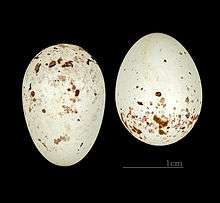Grey-capped greenfinch
The grey-capped greenfinch or Oriental greenfinch (Chloris sinica) is a small passerine bird in the finch family Fringillidae that breeds in broadleaf and conifer woodlands of the East Palearctic.
| Grey-capped greenfinch | |
|---|---|
.jpg) | |
| Scientific classification | |
| Kingdom: | Animalia |
| Phylum: | Chordata |
| Class: | Aves |
| Order: | Passeriformes |
| Family: | Fringillidae |
| Subfamily: | Carduelinae |
| Genus: | Chloris |
| Species: | C. sinica |
| Binomial name | |
| Chloris sinica (Linnaeus, 1766) | |
| Synonyms | |
| |

The grey-capped greenfinch is a medium-sized finch 12.5 to 14 cm (4.9 to 5.5 in) in length, with a strong bill and a short slightly forked tail. It nests in trees or bushes, laying 3-5 eggs.[2]
In 1760 the French zoologist Mathurin Jacques Brisson included a description of the grey-capped greenfinch in his Ornithologie based on a specimen collected in China. He used the French name Le pinçon de la Chine and the Latin Fringilla sinencis.[3] Although Brisson coined Latin names, these do not conform to the binomial system and are not recognised by the International Commission on Zoological Nomenclature.[4] When in 1766 the Swedish naturalist Carl Linnaeus updated his Systema Naturae for the twelfth edition, he added 240 species that had been previously described by Brisson.[4] One of these was the grey-capped greenfinch. Linnaeus included a brief description, coined the binomial name Fringilla sinica and cited Brisson's work.[5] The type locality was subsequently restricted to Macau in eastern China.[6] The specific name sinica is Medieval Latin for Chinese.[7]
The greenfinches were later placed in the genus Carduelis but when molecular phylogenetic studies found that they were not closely related to the other species in Carduelis, the greenfinches were moved to the resurrected genus Chloris.[8][9] The genus had been introduced by the French naturalist Georges Cuvier in 1800.[10] The word Chloris is from the Ancient Greek khlōris for a European greenfinch; the specific epithet sinica is Mediaeval Latin for "Chinese".[11]
Five subspecies are now recognised:[9]
- C. s. ussuriensis Hartert, 1903 – northeastern China, Korea and eastern Siberia
- C. s. kawarahiba (Temminck, 1836) – Kamchatka Peninsula, Kuril Islands and northeastern Hokkaido
- C. s. minor (Temminck & Schlegel, 1848) – Japan: southern Hokkaido to Kyushu
- C. s. kittlitzi (Seebohm, 1890) – Bonin Islands including Iwo Jima
- C. s. sinica (Linnaeus, 1766) – central and eastern China to central Vietnam
References
- BirdLife International (2012). "Carduelis sinica". IUCN Red List of Threatened Species. 2012. Retrieved 26 November 2013.CS1 maint: ref=harv (link)
- Clement, P. (2017). del Hoyo, J.; Elliott, A.; Sargatal, J.; Christie, D.A.; de Juana, E. (eds.). "Oriental Greenfinch (Chloris sinica)". Handbook of the Birds of the World Alive. Lynx Edicions. Retrieved 23 October 2017.
- Brisson, Mathurin Jacques (1760). Ornithologie, ou, Méthode contenant la division des oiseaux en ordres, sections, genres, especes & leurs variétés (in French and Latin). Volume 3. Paris: Jean-Baptiste Bauche. pp. 175–177, Plate 7 fig 2. The two stars (**) at the start of the section indicates that Brisson based his description on the examination of a specimen.
- Allen, J.A. (1910). "Collation of Brisson's genera of birds with those of Linnaeus". Bulletin of the American Museum of Natural History. 28: 317–335.
- Linnaeus, Carl (1766). Systema naturae : per regna tria natura, secundum classes, ordines, genera, species, cum characteribus, differentiis, synonymis, locis (in Latin). Volume 1, Part 1 (12th ed.). Holmiae (Stockholm): Laurentii Salvii. p. 321.
- Paynter, Raymond A. Jr, ed. (1968). Check-list of birds of the world. Volume 14. Cambridge, Massachusetts: Museum of Comparative Zoology. p. 236.
- Jobling, J.A. (2018). del Hoyo, J.; Elliott, A.; Sargatal, J.; Christie, D.A.; de Juana, E. (eds.). "Key to Scientific Names in Ornithology". Handbook of the Birds of the World Alive. Lynx Edicions. Retrieved 1 May 2018.
- Zuccon, Dario; Prŷs-Jones, Robert; Rasmussen, Pamela C.; Ericson, Per G.P. (2012). "The phylogenetic relationships and generic limits of finches (Fringillidae)" (PDF). Molecular Phylogenetics and Evolution. 62 (2): 581–596. doi:10.1016/j.ympev.2011.10.002. PMID 22023825.
- Gill, Frank; Donsker, David (eds.). "Finches, euphonias". World Bird List Version 5.2. International Ornithologists' Union. Retrieved 5 June 2015.
- Cuvier, Georges (1800). Leçons d'anatomie comparée. Volume 1. Paris: Baudouin. Table 2. The year on the title page is An VIII.
- Jobling, James A. (2010). The Helm Dictionary of Scientific Bird Names. London: Christopher Helm. pp. 102, 357. ISBN 978-1-4081-2501-4.
External links
| Wikispecies has information related to Chloris sinica |
| Wikimedia Commons has media related to Chloris sinica. |

.jpg)